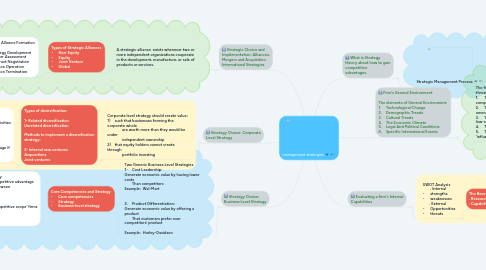
1. Strategy Choice: Business Level Strategy
1.1. Two Generic Business Level Strategies 1- Cost Leadership: Generate economic value by having lower costs Than competitors Example: Wal-Mart 2. Product Differentiation: Generate economic value by offering a product That customers prefer over competitors’ product Example: Harley-Davidson
1.1.1. Core Competencies and Strategy - Core competencies - Strategy - Business-level strategy
1.1.1.1. Business level-strategy Two types of competitive advantage firms must choose between 1. Cost 2. Uniqueness 3. Two types of ‘competitive scope’ firms must choose between 1. Broad target 2. Narrow target
1.1.1.1.1. In relationship to the 5 Forces: 1. Rivalry against existing competitors: Customers are loyal 2. Bargaining Power of Buyers (Customers): Inverse relationship between loyalty/product price sensitivity 3. Bargaining Power of Suppliers: Provide high quality components, driving up firm’s costs; Cost may be passed on to customer 4. Potential Entrants: Substantial barriers; require significant resource investment 5. Product Substitutes: Customer loyalty effectively positions firm
2. Strategy Choice: Corporate Level Strategy
2.1. Corporate level strategy should create value: 1) such that businesses forming the corporate whole are worth more than they would be under independent ownership 2) that equity holders cannot create through portfolio investing
2.1.1. Types of diversification: 1- Related diversification Unrelated diversification Methods to implement a diversification strategy: 2- Internal new ventures Acquisitions Joint ventures
2.1.1.1. Economies of Scope • A case of synergy—combined activities generate Greater value than independent activities • May generate competitive advantage if they Meet the VRIO criteria
3. Strategic Choice and Implementation: Alliances, Mergers and Acquisition, International Strategies
3.1. A strategic alliance exists whenever two or more independent organizations cooperate in the development, manufacture, or sale of products or services.
3.1.1. Types of Strategic Alliances • Non-Equity • Equity • Joint Venture • Global
3.1.1.1. Stages of Alliance Formation • Strategy Development • Partner Assessment • Contract Negotiation • Alliance Operation • Alliance Termination
3.1.1.1.1. International Strategy International strategy define as Strategies used by firms that operate in multiple countries simultaneously. Requires the following: 1. Analyzing the international market 2. Studying resources, defining goals 3. Understanding market dynamics & develop offerings.
4. What is Strategy theory about how to gain competitive advantages.
4.1. Strategic Management Process
4.1.1. Strategic Choice • Business-level strategies • Corporate-level strategies
4.1.1.1. Measuring Group of Accounting Performance 1. Profitability 2. Liquidity 3. Leverage 4. Activity
4.1.1.1.1. Accounting performance • Average • Below • above Average
5. Firm’s General Environment The elements of General Environment: 1. Technological Change 2. Demographic Trends 3. Cultural Trends 4. The Economic Climate 5. Legal And Political Conditions 6. Specific International Events
5.1. The five common environmental threats 1. Threat from new competition 2. Threat from competition among existing competitors 3. Threat from superior or low-cost substitutes 4. Threat of supplier leverage 5. Threats from buyers ‘influence
5.1.1. Threat from new competition 1. Economies of scale—firm that can’t produce the minimum efficient scale will be at a Disadvantage. 2. Product differentiation means that incumbent firms possess brand identification and customer loyalty that potential new competitors do not. 3. Cost advantages independent of scale incumbents may have learning advantages, and so on. 4. Government policies governments may impose trade restrictions and/or grant monopolies
5.1.1.1. Industry Structure and Environmental Opportunities 1. Fragmented Industries 2. Emerging Industries 3. Mature Industries 4. Declining Industries 5. International Industries
6. Evaluating a firm's Internal Capabilities
6.1. SWOT Analysis . Internal - strengths - weaknesses . External - Opportunities - threats
6.1.1. The Resource-Based View . Resources . Capabilities
6.1.1.1. The Internal Analysis Tool VRIO The criteria are: 1. Value 2. Rarity 3. Imitability 4. Organization
